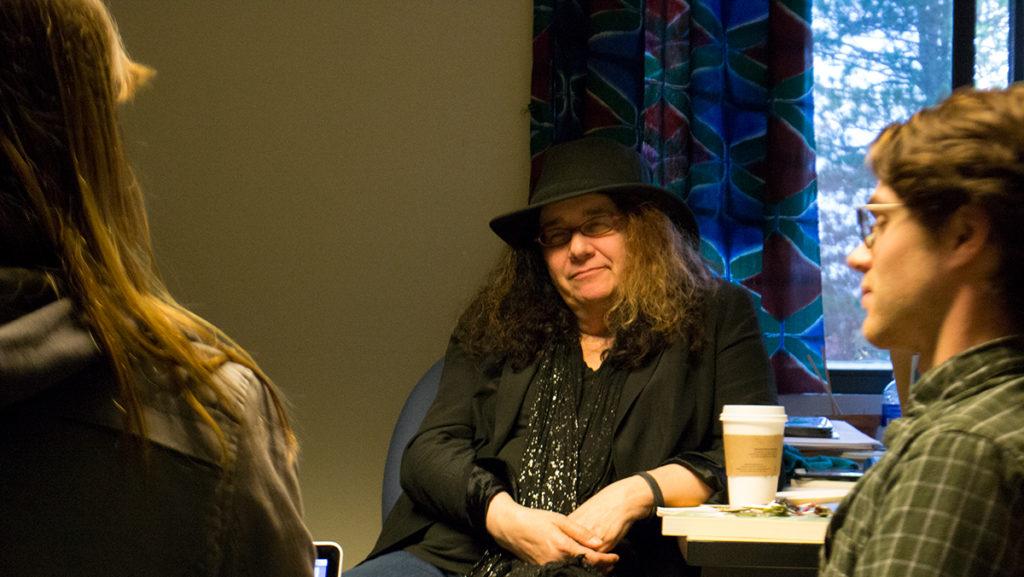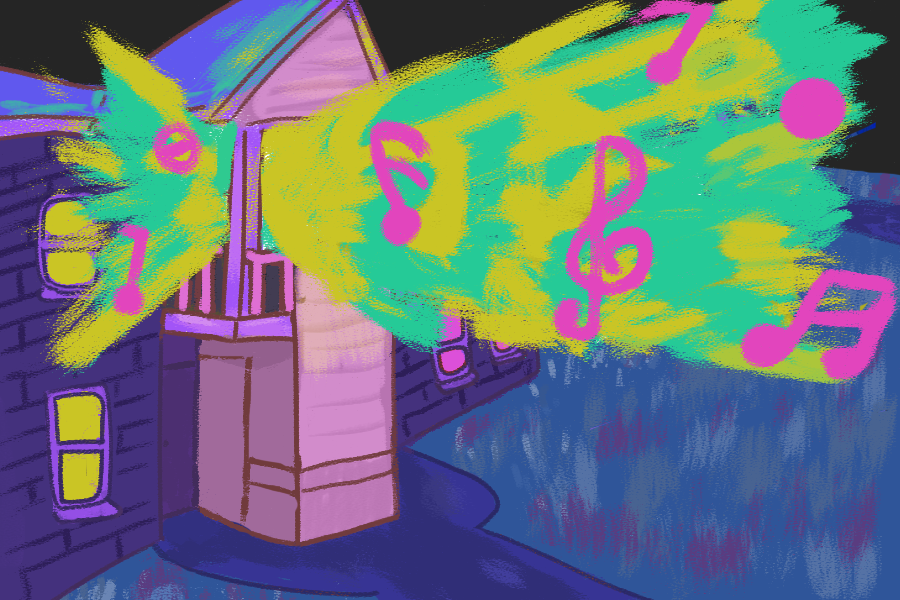A small group of students sits in a circle among stacks of books under yellow lighting in the office of Fae Dremock, assistant professor in the Department of Environmental Studies and Sciences, discussing the ecological importance of honeybees and beekeepers.
It’s not for a class project or a faculty-student research collaboration — it’s the subject of a feature for Ithaca College’s only student-run environmental journal, Alluvian.
Dremock assumed senior Sydney O’Shaughnessy would want to write a feature for the next issue, “Cohesion,” which will focus on the interconnectedness of different environments. When O’Shaughnessy said she hoped to write about the honeybees, senior Peter Zibinski briefly expressed his concern that the story may not encompass the “broader scope” of the issue, but after a brief back and forth, the disagreement was resolved.
Alluvian, an online environmental journal published each season, is affiliated with the Department of Environmental Studies and Sciences at the college. The editorial board consists of co-founders Zibinski, an integrated marketing communications major, and O’Shaughnessy, a journalism and environmental science double major; and editorial assistant Ryan Kresge, a junior environmental studies major.
O’Shaughnessy, who is from a rural town, said she grew up outdoors and has always been fascinated with National Geographic magazine. Her combined love of nature and admiration for the writing in the magazine prompted her to double major in journalism and environmental science at the college.
“I want to be a science writer,” she said. “So that is why this is so perfect for me. … That’s what I’ve wanted to do my whole life.”
Atypical of most journals, editors at Alluvian prefer writing that is driven by a narrative style. The first issue of the journal, released online Oct. 20, “Nature and the City,” is about nature’s relationship with the urban world, focusing on the sustainable potential of cities as much as on their downfalls. In writing about heat islands — areas of higher-than-normal temperatures concentrated in densely populated cities — O’Shaughnessy takes her reader through the scorching hot day of a Philadelphia office worker who finds shade and coolness on the grass below a sycamore tree.
Jason Hamilton, professor and chair of the Department of Environmental Studies and Sciences, said Alluvian’s writing style does not take away from informing the reader of the broader issues. In fact, he said Alluvian’s artistic and narrative-driven style helps fill a void in the science world: clear communication with people outside the field.
“I think that this sort of writing and communication is in fact exactly what we need,” he said. “We need to have ways of writing and speaking and communicating that take the information that the scientists have and communicate it in a way that people can hear.”
Denise O’Leary, a senior environmental science major at the college, wrote a piece about the loss and eventual replanting of a tree on her street corner in the Bronx, a borough of New York City. Written in a chronological format, the article goes in depth about the subculture of her neighborhood. O’Leary portrays the importance of vegetation in an urban setting as well as the lack of motivation to plant vegetation in New York City. This is the style of sensory-heavy journalism Kresge said he appreciates about the submissions Alluvian receives.
“Constantly, people are talking about just, like, their family or a place that means a lot to them or, you know, why they decided to do the things that they’re doing with their life,” Kresge said. “I think that’s a really wonderful, wonderful platform for learning.”
Kresge’s upbringing and experiences with nature have morphed his environmental views. Growing up in a family that valued hunting and fishing, Kresge strayed from that culture as he began to question its morality.
“I started to get a little older and question why we were doing those things, and I stopped,” he said. “Then I came to school and I started to read all of these environmental writers … it just kind of made me realize that no matter what we’re doing, it’s causing violence. To survive means that things need to die.”
Dremock also has her own reasons for helping Zibinski, O’Shaughnessy and Kresge create and maintain their journal. Growing up in a poor community in Texas, she said, she saw firsthand the intersection between social inequalities and environmental issues.
“I spent a lot of my childhood unsupervised out in the fields playing with tarantulas … lizards, which we would wear on our clothes and go to school with,” she said. “So my background in this and my love for it comes from environmental justice issues and social issues.”
The passion that fuels what the group writes, edits and publishes stems from different upbringings. All four of them bringing a certain knowledge base to the table.
“All four of us are pretty laid back, pretty relaxed, pretty eccentric, pretty odd and pretty passionate about what we care about,” Dremock said.














